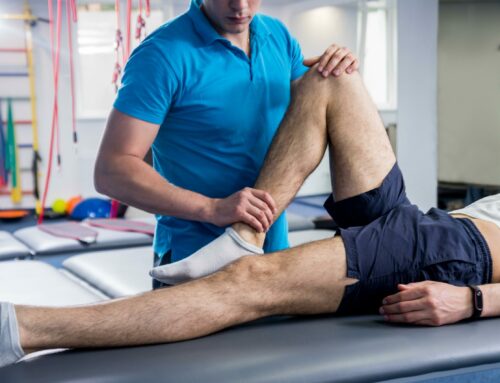 Back pain can range from inconvenient to incapacitating. If you’re experiencing severe pain that doesn’t go away, you should ask yourself “who do I see for back pain?” With so many different types of providers and techniques out there, it can be tough to find the right answer. To top it all off, you might choose the wrong one and waste your time, effort, and, worst of all, money without getting anywhere.
Back pain can range from inconvenient to incapacitating. If you’re experiencing severe pain that doesn’t go away, you should ask yourself “who do I see for back pain?” With so many different types of providers and techniques out there, it can be tough to find the right answer. To top it all off, you might choose the wrong one and waste your time, effort, and, worst of all, money without getting anywhere.
The majority of acute or chronic low back pain is mechanical in nature. That means there is an irritating tissue or structure causing pain. Acute injuries, such as “throwing your back out,” are more akin to spraining a joint and have all of the characteristics of that type of injury. As the body heals the injury, you will experience sharp pain, swelling, heat, and muscle spasms.
Learning More About Your Pain
Acute injuries like this frequently respond very well to physical therapy or chiropractic care. Both methods emphasize early mobilization or manipulation in order to remove the irritated structure. They do it slightly differently, but the results are usually pretty good. Indeed, according to a study published in the journal BMC Health Services, “Early physical therapy (PT) for low back pain (LBP) was associated with less 30-day and 1-year healthcare utilization and less30-day LBP-related spending.” This means that treating low back pain early required less care and money than waiting.
More pain with movement is frequently associated with low back pain. Seeing a chiropractor or physical therapist can now help identify which structures are causing pain and develop movement strategies to prevent further injury. It is important to remember that not all pain is harmful. Your body’s signal to stop moving is sharp, burning, increased numbness, or shooting pain. If you’re feeling dull, achy, or sore, it may be a sign that you need to get moving. This is one of the main goals of chiropractic or physical therapy treatment.
Gone are the days of bed rest and avoidance. Why? Because it didn’t work. According to the Journal of Orthopaedic and Sports Physical Therapy Systematic Review, “There was a moderate certainty of evidence that exercise therapy is effective for reducing movement-evoked pain in patients with musculoskeletal pain compared to no treatment. Consider exercise therapy as the first-choice treatment for movement-evoked pain in clinical practice.”
What Should You Do If You’re in Pain?
It is important to remember that sometimes a little guidance on beneficial or harmful movement and exercise therapy can go a long way toward achieving a successful outcome. For most people, early intervention and quicker, less expensive treatment will necessitate a visit to a trained professional who knows a thing or two about anatomy and back pain. YouTube and TikTok are typically insufficient because there is a subtle nuance that can only be discovered by a trained professional such as a physical therapist or chiropractor.
Any pain that lasts longer than six weeks is considered chronic. This type of pain is more difficult to treat and frequently necessitates more visits and different strategies. Chiropractic care is one of the most common treatments. This is due to the fact that untreated acute injuries frequently result in muscle spasms, movement avoidance by the patient, and loss of joint movement between the vertebrae.
As time passes, the joints become stiffer and stiffer until something gives, at which point the pain becomes worse or sharper. Chiropractic manipulation is a treatment that aims to restore proper joint range of motion and alignment first and foremost. This relieves pressure or pinch on the nerves, reduces muscle tension, and allows for proper movement and function.
According to the Journal of Chiropractic Medicine, “This retrospective review of 217 individuals revealed clinically and statistically significant improvement in a numeric rating scale (34.1% reduction) and the Back Bournemouth Questionnaire scores (35.9% reduction) for this sample of older male U. S. Veterans treated with chiropractic management for low back pain.”
Based on Our Experience
We treat a lot of elderly patients, and every single one of them is overjoyed to have less pain after chiropractic treatment. It is not insignificant to reduce your pain from a 9 to a 6. We get better results in our clinic because we do more than just straight chiropractic treatment, but the point is that it is a highly effective treatment on its own. As more people and doctors look for non-drug and non-surgical options, massage therapy and acupuncture treatments can be added to the list of effective treatments for low back pain.
Myofascial release and manual therapy have a long history of helping people with low back pain. In addition to pain and swelling, myofascial adhesions are common in the low back. If you suffer from low back pain, a trained massage therapist can be of great assistance to you. The Journal of Bodywork and Movement Therapies: “The improvements in the outcomes measures suggest that lumbar myofascial release may be effective in subjects with non-specific low back pain”
Acupuncture can be a great resource for low back pain when we are dealing with knots or trigger points. Acupuncture in Medicine: “Real Dry Needling induced an immediate analgesic response (made it better) at both myofascial trigger points and control locations, while sham dry needling induced an immediate myofascial trigger point response (made it worse)”
What Happens When We Start Combining Treatments?
We’ve discovered that when we look at the various aspects of pain and injury and begin treating them appropriately, treatments and recovery go faster and produce better results. That’s why consider incorporating acupuncture trigger point treatment into physical therapy.
Journal of Acupuncture and Meridian Studies: “Compared with exercise alone, exercise and trigger point acupuncture may be a more effective therapy for older people with chronic low back pain who don’t have an exercise habit.”
Our clinic offers a range of services including chiropractic care, physical therapy, massage therapy, and acupuncture. This means we can usually find a combination of treatments to address each individual’s needs. This enables us to achieve better results than if we practiced alone.


